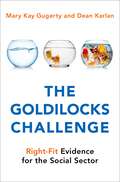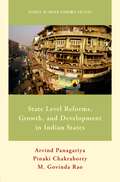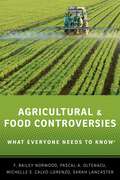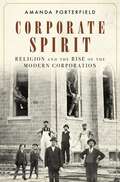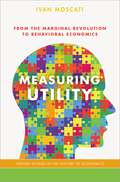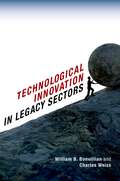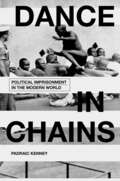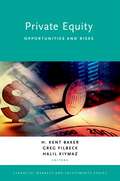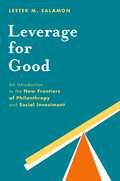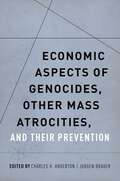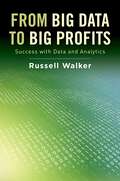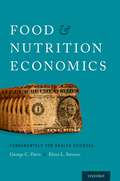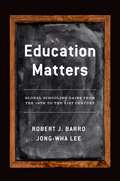- Table View
- List View
The Goldilocks Challenge: Right-Fit Evidence for the Social Sector
by Mary Kay Gugerty Dean KarlanThe social sector provides services to a wide range of people throughout the world with the aim of creating social value. While doing good is great, doing it well is even better. These organizations, whether nonprofit, for-profit, or public, increasingly need to demonstrate that their efforts are making a positive impact on the world, especially as competition for funding and other scarce resources increases. This heightened focus on impact is positive: learning whether we are making a difference enhances our ability to address pressing social problems effectively and is critical to wise stewardship of resources. Yet demonstrating efficacy remains a big hurdle for most organizations. The Goldilocks Challenge provides a parsimonious framework for measuring the strategies and impact of social sector organizations. A good data strategy starts first with a sound theory of change that helps organizations decide what elements they should monitor and measure. With a theory of change providing solid underpinning, the Goldilocks framework then puts forward four key principles, the CART principles: Credible data that are high quality and analyzed appropriately, Actionable data will actually influence future decisions; Responsible data create more benefits than costs; and Transportable data build knowledge that can be used in the future and by others. Mary Kay Gugerty and Dean Karlan combine their extensive experience working with nonprofits, for-profits and government with their understanding of measuring effectiveness in this insightful guide to thinking about and implementing evidence-based change. This book is an invaluable asset for nonprofit, social enterprise and government leaders, managers, and funders-including anyone considering making a charitable contribution to a nonprofit-to ensure that these organizations get it "just right" by knowing what data to collect, how to collect it, how it can be analyzed, and drawing implications from the analysis. Everyone who wants to make positive change should focus on the top priority: using data to learn, innovate, and improve program implementation over time. Gugerty and Karlan show how.
Private Governance: Creating Order in Economic and Social Life
by Edward Peter StringhamFrom the first stock markets of Amsterdam,London, and New York to the billions of electronic commerce transactions today, privately produced and enforced economic regulations are more common, more effective, and more promising than commonly considered. In Private Governance, prominent economist Edward Stringham presents case studies of the various forms of private enforcement, self-governance, or self-regulation among private groups or individuals that fill a void that government enforcement cannot. Through analytical narratives the book provides a close examination of the world's first stock markets, key elements of which were unenforceable by law; the community of Celebration, Florida, and other private communities that show how public goods can be bundled with land and provided more effectively; and the millions of credit-card transactions that occur daily and are regulated by private governance. Private Governance ultimately argues that while potential problems of private governance, such as fraud, are pervasive, so are the solutions it presents, and that much of what is orderly in the economy can be attributed to private groups and individuals. With meticulous research, Stringham demonstrates that private governance is a far more common source of order than most people realize, and that private parties have incentives to devise different mechanisms for eliminating unwanted behavior. Private Governance documents numerous examples of private order throughout history to illustrate how private governance is more resilient to internal and external pressure than is commonly believed. Stringham discusses why private governance has economic and social advantages over relying on government regulations and laws, and explores the different mechanisms that enable private governance, including sorting, reputation, assurance, and other bonding mechanisms. Challenging and rigorously-written, Private Governance will make a compelling read for those with an interest in economics, political philosophy, and the history of current Wall Street regulations.
Trade Usages and Implied Terms in the Age of Arbitration
If a dispute between commercial parties reaches the stage of arbitration, the cause is usually ambiguous contract terms. The arbitrator often resolves the dispute by applying trade usages, either to interpret the ambiguous terms or to determine what the given contract's terms really are. This recourse to trade usages does not create many problems on the domestic level. However, international arbitrations are far more complex and confusing. Trade Usages and Implied Terms in the Age of Arbitration provides a clear explanation of how usages, and more generally the implicit or implied content of international commercial contracts, are approached by some of the most influential legal systems in the world. Building on these approaches and taking account of arbitral practice, this book explores possible conceptual frameworks to help shape the emerging transnational law of trade usage. Part I covers the treatment and conceptual grounding of usages and implied terms in the positive law of influential jurisdictions. Part II defines the approach to usages and implied terms adopted in the design and implementation of important uniform law instruments dealing with international business contracts, as well as in the practice of international commercial arbitration. Part III concludes the book with an outline of what the conceptual grounding of trade usages could be in the transnational law of commercial contracts.
State Level Reforms, Growth, and Development in Indian States (Studies in Indian Economic Policies)
by Pinaki Chakraborty M. Govinda Rao Arvind PanagariyaMost discussions of India's recent economic growth focus on progress and policies at the national level. But with a population of 1.2 billion, several of the states in India are larger than many of the countries in the world. Therefore, a more complete understanding of India's ongoing experiment in economic reforms requires a study at the state level. State Level Reforms, Growth, and Development in Indian States provides the first-ever comprehensive analysis of growth and reforms in the highly diverse states of the country. The authors argue that when the national government loosened its controls on industry and services, state governments began shaping the fortunes of their citizens through state-level policy reforms, resulting in faster growth in every state over the last decade than any other decade in the post-independence era. In fact, some of the poorest states, notably Bihar and Odisha, have been growing the fastest. Professors Panagariya and Chakraborty and Dr. Rao refute the common assumptions that growth has not occurred or that poverty has not been reduced in all Indian states. The recent reforms have also led to improved access in every state to basic amenities such as permanent houses, electricity, water, and sanitation. These accomplishments notwithstanding, regional inequality on a per capita basis has grown as well. The authors analyze the economic transformation that has taken place in the largest eighteen states of India and suggest reforms in areas of agriculture, industry, services and urbanization that can further accelerate this transformation. They also provide a comprehensive analysis of education and health in the states.
Agricultural and Food Controversies: What Everyone Needs to Know® (What Everyone Needs To Know®)
by F. Bailey Norwood Pascal A. Oltenacu Michelle S. Calvo-Lorenzo Sarah LancasterThe world is more interested in issues surrounding agricultural and food issues than ever before. Are pesticides safe? Should we choose locally grown food? Why do some people embrace new agricultural technologies while others steadfastly defend traditional farming methods? In the debates about organic food, genetically modified organisms, and farm animal welfare, it's not always clear what the scientific studies are actually telling us. To understand these controversies and more, the authors of Agricultural and Food Controversies: What Everyone Needs to Know begin by encouraging readers to develop an understanding of how two well-educated people can form radically different opinions about food. Sometimes the disputes are scientific in nature, and sometimes they arise from conflicting ethical views. This book confronts the most controversial issues in agriculture by first explaining the principles of each side of the debate, guiding readers through the scientific literature so that they can form their own educated opinions. Questions asked: - Are organic foods truly better for your health? - Are chemical fertilizers sustainable, or are we producing cheap food at the expense of future generations? - What foods should we eat to have a smaller carbon footprint? - Does buying local food stimulate the local economy? - Why are so many farm animals raised indoors? - Should antibiotics be given to livestock? - Is genetically-modified food the key to global food security, and does it give corporations too much market power? - Is the prevalence of corn throughout the food system the result of farm subsidies? Providing a combination of research and popular opinions on both sides of the issue, Agricultural and Food Controversies: What Everyone Needs to Know allows readers to decide for themselves what they personally value and believe to be important when it comes to their food.
Agricultural and Food Controversies: What Everyone Needs to Know® (What Everyone Needs To Know®)
by F. Bailey Norwood Pascal A. Oltenacu Michelle S. Calvo-Lorenzo Sarah LancasterThe world is more interested in issues surrounding agricultural and food issues than ever before. Are pesticides safe? Should we choose locally grown food? Why do some people embrace new agricultural technologies while others steadfastly defend traditional farming methods? In the debates about organic food, genetically modified organisms, and farm animal welfare, it's not always clear what the scientific studies are actually telling us. To understand these controversies and more, the authors of Agricultural and Food Controversies: What Everyone Needs to Know begin by encouraging readers to develop an understanding of how two well-educated people can form radically different opinions about food. Sometimes the disputes are scientific in nature, and sometimes they arise from conflicting ethical views. This book confronts the most controversial issues in agriculture by first explaining the principles of each side of the debate, guiding readers through the scientific literature so that they can form their own educated opinions. Questions asked: - Are organic foods truly better for your health? - Are chemical fertilizers sustainable, or are we producing cheap food at the expense of future generations? - What foods should we eat to have a smaller carbon footprint? - Does buying local food stimulate the local economy? - Why are so many farm animals raised indoors? - Should antibiotics be given to livestock? - Is genetically-modified food the key to global food security, and does it give corporations too much market power? - Is the prevalence of corn throughout the food system the result of farm subsidies? Providing a combination of research and popular opinions on both sides of the issue, Agricultural and Food Controversies: What Everyone Needs to Know allows readers to decide for themselves what they personally value and believe to be important when it comes to their food.
Distant Markets, Distant Harms: Economic Complicity and Christian Ethics
Does a consumer who bought a shirt made in another nation bear any moral responsibility when the women who sewed that shirt die in a factory fire or in the collapse of the building? Many have asserted, without explanation, that because markets cause harms to distant others, consumers bear moral responsibility for those harms. But traditional moral analysis of individual decisions is unable to sustain this argument. Distant Harms, Distant Markets presents a careful analysis of moral complicity in markets, employing resources from sociology, Christian history, feminism, legal theory, and Catholic moral theology today. Because of its individualistic methods, mainstream economics as a discipline is not equipped to understand the causality entailed in the long chains of social relationships that make up the market. Critical realist sociology, however, has addressed the character and functioning of social structures, an analysis that can helpfully be applied to the market. The True Wealth of Nations research project of the Institute for Advanced Catholic Studies brought together an international group of sociologists, economists, moral theologians, and others to describe these causal relationships and articulate how Catholic social thought can use these insights to more fully address issues of economic ethics in the twenty-first century. The result was this interdisciplinary volume of essays, which explores the causal and moral responsibilities that consumers bear for the harms that markets cause to distant others.
The Oxford Handbook of Food Ethics (Oxford Handbooks)
Academic food ethics incorporates work from philosophy but also anthropology, economics, the environmental sciences and other natural sciences, geography, law, and sociology. Scholars from these fields have been producing work for decades on the food system, and on ethical, social, and policy issues connected to the food system. Yet in the last several years, there has been a notable increase in philosophical work on these issues-work that draws on multiple literatures within practical ethics, normative ethics and political philosophy. This handbook provides a sample of that philosophical work across multiple areas of food ethics: conventional agriculture and alternatives to it; animals; consumption; food justice; food politics; food workers; and, food and identity.
Corporate Spirit: Religion and the Rise of the Modern Corporation
by Amanda PorterfieldIn this groundbreaking work, Amanda Porterfield explores the long intertwining of religion and commerce in the history of incorporation in the United States. Beginning with the antecedents of that history in western Europe, she focuses on organizations to show how corporate strategies in religion and commerce developed symbiotically, and how religion has influenced the corporate structuring and commercial orientation of American society. Porterfield begins her story in ancient Rome. She traces the development of corporate organization through medieval Europe and Elizabethan England and then to colonial North America, where organizational practices derived from religion infiltrated commerce, and commerce led to political independence. Left more to their own devices than under British law, religious groups in the United States experienced unprecedented autonomy that facilitated new forms of communal governance and new means of broadcasting their messages. As commercial enterprise expanded, religious organizations grew apace, helping many Americans absorb the shocks of economic turbulence, and promoting new conceptions of faith, spirit, and will power that contributed to business. Porterfield highlights the role that American religious institutions played a society increasingly dominated by commercial incorporation and free market ideologies. She also shows how charitable impulses long nurtured by religion continued to stimulate reform and demand for accountability.
Corporate Spirit: Religion and the Rise of the Modern Corporation
by Amanda PorterfieldIn this groundbreaking work, Amanda Porterfield explores the long intertwining of religion and commerce in the history of incorporation in the United States. Beginning with the antecedents of that history in western Europe, she focuses on organizations to show how corporate strategies in religion and commerce developed symbiotically, and how religion has influenced the corporate structuring and commercial orientation of American society. Porterfield begins her story in ancient Rome. She traces the development of corporate organization through medieval Europe and Elizabethan England and then to colonial North America, where organizational practices derived from religion infiltrated commerce, and commerce led to political independence. Left more to their own devices than under British law, religious groups in the United States experienced unprecedented autonomy that facilitated new forms of communal governance and new means of broadcasting their messages. As commercial enterprise expanded, religious organizations grew apace, helping many Americans absorb the shocks of economic turbulence, and promoting new conceptions of faith, spirit, and will power that contributed to business. Porterfield highlights the role that American religious institutions played a society increasingly dominated by commercial incorporation and free market ideologies. She also shows how charitable impulses long nurtured by religion continued to stimulate reform and demand for accountability.
Measuring Utility: From the Marginal Revolution to Behavioral Economics (Oxford Studies in History of Economics)
by Ivan MoscatiUtility is a key concept in the economics of individual decision-making. However, utility is not measurable in a straightforward way. As a result, from the very beginning there has been debates about the meaning of utility as well as how to measure it. This book is an innovative investigation of how these arguments changed over time. Measuring Utility reconstructs economists' ideas and discussions about utility measurement from 1870 to 1985, as well as their attempts to measure utility empirically. The book brings into focus the interplay between the evolution of utility analysis, economists' ideas about utility measurement, and their conception of what measurement in general means. It also explores the relationships between the history of utility measurement in economics, the history of the measurement of sensations in psychology, and the history of measurement theory in general. Finally, the book discusses some methodological problems related to utility measurement, such as the epistemological status of the utility concept and its measures. The first part covers the period 1870-1910, and discusses the issue of utility measurement in the theories of Jevons, Menger, Walras and other early utility theorists. Part II deals with the emergence of the notions of ordinal and cardinal utility during the period 1900-1945, and discusses two early attempts to give an empirical content to the notion of utility. Part III focuses on the 1945-1955 debate on utility measurement that was originated by von Neumann and Morgenstern's expected utility theory (EUT). Part IV reconstructs the experimental attempts to measure the utility of money between 1950 and 1985 within the framework provided by EUT. This historical and epistemological overview provides keen insights into current debates about rational choice theory and behavioral economics in the theory of individual decision-making and the philosophy of economics.
MEASURING UTILITY OSHEC C: From the Marginal Revolution to Behavioral Economics (Oxford Studies in History of Economics)
by Ivan MoscatiUtility is a key concept in the economics of individual decision-making. However, utility is not measurable in a straightforward way. As a result, from the very beginning there has been debates about the meaning of utility as well as how to measure it. This book is an innovative investigation of how these arguments changed over time. Measuring Utility reconstructs economists' ideas and discussions about utility measurement from 1870 to 1985, as well as their attempts to measure utility empirically. The book brings into focus the interplay between the evolution of utility analysis, economists' ideas about utility measurement, and their conception of what measurement in general means. It also explores the relationships between the history of utility measurement in economics, the history of the measurement of sensations in psychology, and the history of measurement theory in general. Finally, the book discusses some methodological problems related to utility measurement, such as the epistemological status of the utility concept and its measures. The first part covers the period 1870-1910, and discusses the issue of utility measurement in the theories of Jevons, Menger, Walras and other early utility theorists. Part II deals with the emergence of the notions of ordinal and cardinal utility during the period 1900-1945, and discusses two early attempts to give an empirical content to the notion of utility. Part III focuses on the 1945-1955 debate on utility measurement that was originated by von Neumann and Morgenstern's expected utility theory (EUT). Part IV reconstructs the experimental attempts to measure the utility of money between 1950 and 1985 within the framework provided by EUT. This historical and epistemological overview provides keen insights into current debates about rational choice theory and behavioral economics in the theory of individual decision-making and the philosophy of economics.
Technological Innovation in Legacy Sectors
by William B. Bonvillian Charles WeissThe American economy faces two deep problems: expanding innovation and raising the rate of quality job creation. Both have roots in a neglected problem: the resistance of Legacy economic sectors to innovation. While the U.S. has focused its policies on breakthrough innovations to create new economic frontiers like information technology and biotechnology, most of its economy is locked into Legacy sectors defended by technological/ economic/ political/ social paradigms that block competition from disruptive innovations that could challenge their models. Americans like to build technology "covered wagons" and take them "out west" to open new innovation frontiers; we don't head our wagons "back east" to bring innovation to our Legacy sectors. By failing to do so, the economy misses a major opportunity for innovation, which is the bedrock of U.S. competitiveness and its standard of living. Technological Innovation in Legacy Sectors uses a new, unifying conceptual framework to identify the shared features underlying structural obstacles to innovation in major Legacy sectors: energy, air and auto transport, the electric power grid, buildings, manufacturing, agriculture, health care delivery and higher education, and develops approaches to understand and transform them. It finds both strengths and obstacles to innovation in the national innovation environments - a new concept that combines the innovation system and the broader innovation context - for a group of Asian and European economies. Manufacturing is a major Legacy sector that presents a particular challenge because it is a critical stage in the innovation process. By increasingly offshoring production, the U.S. is losing important parts of its innovation capacity. "Innovate here, produce here," where the U.S. took all the gains of its strong innovation system at every stage, is being replaced by "innovate here, produce there," which threatens to lead to "produce there, innovate there." To bring innovation to Legacy sectors, authors William Bonvillian and Charles Weiss recommend that policymakers focus on all stages of innovation from research through implementation. They should fill institutional gaps in the innovation system and take measures to address structural obstacles to needed disruptive innovations. In the specific case of advanced manufacturing, the production ecosystem can be recreated to reverse "jobless innovation" and add manufacturing-led innovation to the U.S.'s still-strong, research-oriented innovation system.
Technological Innovation in Legacy Sectors
by William B. Bonvillian Charles WeissThe American economy faces two deep problems: expanding innovation and raising the rate of quality job creation. Both have roots in a neglected problem: the resistance of Legacy economic sectors to innovation. While the U.S. has focused its policies on breakthrough innovations to create new economic frontiers like information technology and biotechnology, most of its economy is locked into Legacy sectors defended by technological/ economic/ political/ social paradigms that block competition from disruptive innovations that could challenge their models. Americans like to build technology "covered wagons" and take them "out west" to open new innovation frontiers; we don't head our wagons "back east" to bring innovation to our Legacy sectors. By failing to do so, the economy misses a major opportunity for innovation, which is the bedrock of U.S. competitiveness and its standard of living. Technological Innovation in Legacy Sectors uses a new, unifying conceptual framework to identify the shared features underlying structural obstacles to innovation in major Legacy sectors: energy, air and auto transport, the electric power grid, buildings, manufacturing, agriculture, health care delivery and higher education, and develops approaches to understand and transform them. It finds both strengths and obstacles to innovation in the national innovation environments - a new concept that combines the innovation system and the broader innovation context - for a group of Asian and European economies. Manufacturing is a major Legacy sector that presents a particular challenge because it is a critical stage in the innovation process. By increasingly offshoring production, the U.S. is losing important parts of its innovation capacity. "Innovate here, produce here," where the U.S. took all the gains of its strong innovation system at every stage, is being replaced by "innovate here, produce there," which threatens to lead to "produce there, innovate there." To bring innovation to Legacy sectors, authors William Bonvillian and Charles Weiss recommend that policymakers focus on all stages of innovation from research through implementation. They should fill institutional gaps in the innovation system and take measures to address structural obstacles to needed disruptive innovations. In the specific case of advanced manufacturing, the production ecosystem can be recreated to reverse "jobless innovation" and add manufacturing-led innovation to the U.S.'s still-strong, research-oriented innovation system.
Dance in Chains: Political Imprisonment in the Modern World
by Padraic KenneyStates around the world imprison people for their beliefs or politically-motivated actions. Oppositional movements of all stripes celebrate their comrades behind bars. Yet they are more than symbols of repression and human rights. Dance in Chains examines the experiences of political prisoners themselves in order to understand who they are, what they do, and why it matters. This is the first book to trace the history of modern political imprisonment from its origins in the mid-nineteenth century. The letters, diaries, and memoirs of political prisoners, as well as the records of regime policies, relate the contest in the prison cell to political conflicts between regime and opposition. Padraic Kenney draws on examples from regimes ranging from communist and fascist to colonial and democratic, including Ireland, the United Kingdom, Poland, and South Africa. They include the Fenian Brotherhood, imprisoned in England and Ireland in the 1860s, and their successors during the Irish War of Independence and the Northern Ireland Troubles; Afrikaaners suspected of treason during the Boer War; socialists fighting for Polish freedom in the Russian Empire, and then Communists denouncing "bourgeois" rule in newly-independent Poland; the opponents of apartheid South Africa and stalinist Poland; and those imprisoned by the United States in Guantanamo Bay detention camp today. Some prisons are well-known; in others, inmates suffered in obscurity. Through self-organization, education, and actions ranging from solitary non-cooperation to mass hunger strikes, these prisoners transform their incarceration and counter states' efforts to control them. While considering the international movements that have sought to publicize the plight of political prisoners, Dance in Chains examines the actions of the prisoners themselves to find universal answers to questions about the meaning and purpose of their imprisonment.
Dance in Chains: Political Imprisonment in the Modern World
by Padraic KenneyStates around the world imprison people for their beliefs or politically-motivated actions. Oppositional movements of all stripes celebrate their comrades behind bars. Yet they are more than symbols of repression and human rights. Dance in Chains examines the experiences of political prisoners themselves in order to understand who they are, what they do, and why it matters. This is the first book to trace the history of modern political imprisonment from its origins in the mid-nineteenth century. The letters, diaries, and memoirs of political prisoners, as well as the records of regime policies, relate the contest in the prison cell to political conflicts between regime and opposition. Padraic Kenney draws on examples from regimes ranging from communist and fascist to colonial and democratic, including Ireland, the United Kingdom, Poland, and South Africa. They include the Fenian Brotherhood, imprisoned in England and Ireland in the 1860s, and their successors during the Irish War of Independence and the Northern Ireland Troubles; Afrikaaners suspected of treason during the Boer War; socialists fighting for Polish freedom in the Russian Empire, and then Communists denouncing "bourgeois" rule in newly-independent Poland; the opponents of apartheid South Africa and stalinist Poland; and those imprisoned by the United States in Guantanamo Bay detention camp today. Some prisons are well-known; in others, inmates suffered in obscurity. Through self-organization, education, and actions ranging from solitary non-cooperation to mass hunger strikes, these prisoners transform their incarceration and counter states' efforts to control them. While considering the international movements that have sought to publicize the plight of political prisoners, Dance in Chains examines the actions of the prisoners themselves to find universal answers to questions about the meaning and purpose of their imprisonment.
Private Equity: Opportunities and Risks (Financial Markets and Investments)
During the past few decades, private equity (PE) has attracted considerable attention from investors, practitioners, and academicians. In fact, a substantial literature on PE has emerged. PE offers benefits for institutional and private wealth management clients including diversification and enhancement of risk-adjusted returns. However, several factors such as liquidity concerns, regulatory restrictions, and the lack of transparency limit the attractiveness of some PE options to investors. The latest volume in the Financial Markets and Investments Series, Private Equity: Opportunities and Risks offers a synthesis of the theoretical and empirical literature on PE in both emerging and developed markets. Editors H. Kent Baker, Greg Filbeck, Halil Kiymaz and their co-authors examine PE and provide important insights about topics such as major types of PE (venture capital, leveraged buyouts, mezzanine capital, and distressed debt investments), how PE works, performance and measurement, uses and structure, and trends in the market. Readers can gain an in-depth understanding about PE from academics and practitioners from around the world. Private Equity: Opportunities and Risks provides a fresh look at the intriguing yet complex subject of PE. A group of experts takes readers through the core topics and issues of PE, and also examines the latest trends and cutting-edge developments in the field. The coverage extends from discussing basic concepts and their application to increasingly complex and real-world situations. This new and intriguing examination of PE is essential reading for anyone hoping to gain a better understanding of PE, from seasoned professionals to those aspiring to enter the demanding world of finance.
LEVERAGE FOR GOOD C: An Introduction to the New Frontiers of Philanthropy and Social Investment
by Lester M. SalamonWith the resources of both governments and traditional philanthropy barely growing or in decline, yet the problems of poverty, ill-health, and environmental degradation ballooning daily, new models for financing social and environmental objectives are urgently needed. Fortunately, a revolution is underway in the instruments and institutions available to meet this need. Loans, loan guarantees, private equity, barter arrangements, social stock exchanges, bonds, social secondary markets, and investment funds are just some of the actors and tools occupying the new frontiers of philanthropy and social investment. Together they hold the promise of leveraging for social and environmental purposes not just the billions of dollars of charitable grants but the hundreds of billions, indeed trillions, of dollars of private investment capital. While the changes under way are inspiring, they remain largely uncharted. This concise introduction to the topic, and its companion volume, provide the first comprehensive and accessible roadmap to these important advances. In the process, these works will better equip investors, philanthropists, social entrepreneurs, nonprofit leaders, business executives, government officials, and students the world over to capture the opportunities that these developments hold out to them and to our world.
The Oxford Handbook of the Economics of Gambling (Oxford Handbooks)
by Leighton Vaughan WilliamsThere is growing interest among academics and policymakers in the economics of gambling, which has been stimulated by major regulatory and tax changes in the U.S., U.K. Continental Europe, Asia, Australia and elsewhere. Unfortunately, there is no comprehensive source of path-breaking research on this topic. To fill this gap, we commissioned chapters from leading economists on all aspects of gambling research. Topics covered include the optimal taxation structure for various forms of gambling, factors influencing the demand and supply of gambling services, forecasting of gambling trends, regulation of gambling, the efficiency of racetrack and sports betting markets, gambling prevalence and behavior, modeling the demand for gambling services, the economic impact of gambling, substitution and complementarities among different types of gambling activity, and the relationship between gambling and other sectors of the economy. These are all important issues, with significant global implications. Specifically, we divide the Handbook into sections on casinos, sports betting, horserace betting, betting strategy, motivation, behavior and decision-making in betting markets, prediction markets and political betting, and lotteries and gambling machines
The Oxford Handbook of the Economics of Gambling (Oxford Handbooks)
by Donald S. Siegel Leighton Vaughan WilliamsThere is growing interest among academics and policymakers in the economics of gambling, which has been stimulated by major regulatory and tax changes in the U.S., U.K. Continental Europe, Asia, Australia and elsewhere. Unfortunately, there is no comprehensive source of path-breaking research on this topic. To fill this gap, we commissioned chapters from leading economists on all aspects of gambling research. Topics covered include the optimal taxation structure for various forms of gambling, factors influencing the demand and supply of gambling services, forecasting of gambling trends, regulation of gambling, the efficiency of racetrack and sports betting markets, gambling prevalence and behavior, modeling the demand for gambling services, the economic impact of gambling, substitution and complementarities among different types of gambling activity, and the relationship between gambling and other sectors of the economy. These are all important issues, with significant global implications. Specifically, we divide the Handbook into sections on casinos, sports betting, horserace betting, betting strategy, motivation, behavior and decision-making in betting markets, prediction markets and political betting, and lotteries and gambling machines
Economic Aspects of Genocides, Other Mass Atrocities, and Their Prevention
Alongside other types of mass atrocities, genocide has received extensive scholarly, policy, and practitioner attention. Missing, however, is the contribution of economists to better understand and prevent such crimes. This edited collection by 41 accomplished scholars examines economic aspects of genocides, other mass atrocities, and their prevention. Chapters include numerous case studies (e.g., California's Yana people, Australia's Aborigines peoples, Stalin's killing of Ukrainians, Belarus, the Holocaust, Rwanda, DR Congo, Indonesia, Pakistan, Colombia, Mexico's drug wars, and the targeting of suspects during the Vietnam war), probing literature reviews, and completely novel work based on extraordinary country-specific datasets. Also included are chapters on the demographic, gendered, and economic class nature of genocide. Replete with research- and policy-relevant findings, new insights are derived from behavioral economics, law and economics, political economy, macroeconomic modeling, microeconomics, development economics, industrial organization, identity economics, and other fields. Analytical approaches include constrained optimization theory, game theory, and sophisticated statistical work in data-mining, econometrics, and forecasting. A foremost finding of the book concerns atrocity architects' purposeful, strategic use of violence, often manipulating nonrational proclivities among ordinary people to sway their participation in mass murder. Relatively understudied in the literature, the book also analyzes the options of victims before, during, and after mass violence. Further, the book shows how well-intended prevention efforts can backfire and increase violence, how wrong post-genocide design can entrench vested interests to reinforce exclusion of vulnerable peoples, and how businesses can become complicit in genocide. In addition to the necessity of healthy opportunities in employment, education, and key sectors in prevention work, the book shows why new genocide prevention laws and institutions must be based on reformulated incentives that consider insights from law and economics, behavioral economics, and collective action economics.
From Big Data to Big Profits: Success with Data and Analytics
by Russell WalkerTechnological advancements in computing have changed how data is leveraged by businesses to develop, grow, and innovate. In recent years, leading analytical companies have begun to realize the value in their vast holdings of customer data and have found ways to leverage this untapped potential. Now, more firms are following suit and looking to monetize Big Data for big profits. Such changes will have implications for both businesses and consumers in the coming years. In From Big Data to Big Profits, Russell Walker investigates the use of Big Data to stimulate innovations in operational effectiveness and business growth. Walker examines the nature of Big Data and how businesses can use it to create new monetization opportunities. Using case studies of Apple, Netflix, Google, LinkedIn, Zillow, Amazon, and other leaders in the use of Big Data, Walker explores how digital platforms such as mobile apps and social networks are changing the nature of customer interactions and the way Big Data is created and used by companies. Such changes, as Walker points out, will require careful consideration of legal and unspoken business practices as they affect consumer privacy. Companies looking to develop a Big Data strategy will find great value in the SIGMA framework, which he has developed to assess companies for Big Data readiness and provide direction on the steps necessary to get the most from Big Data. Rigorous and meticulous, From Big Data to Big Profits is a valuable resource for students, researchers, and professionals with an interest in Big Data, digital platforms, and analytics
Food and Nutrition Economics: Fundamentals for Health Sciences (Food and Public Health)
by George C. Davis Elena L. SerranoWinner of the 2017 Quality of Communication Award presented by The Agricultural and Applied Economics Association As the importance of food and nutrition becomes more widely recognized by practitioners and researchers in the health sciences, one persisting gap in the knowledge base remains: what are the economic factors that influence our food and our health? Food and Nutrition Economics offers a much-needed resource for non-economists looking to understand the basic economic principles that govern our food and nutritional systems. Comprising both a quick grounding in nutrition with the fundamentals of economics and expert applications to food systems, it is a uniquely accessible and much-needed bridge between previously disparate scholarly and professional fields. This book is intended for upper level undergraduates, graduate students, and health professionals with no background in economics who recognize that economics affects much of their work. Concerned because previous encounters with economics have been hampered by math hurdles? Don't be; this book offers a specialized primer in consumer economics (including behavioral economics of food consumption), producer economics, market-level analysis, cost-effectiveness, and cost-benefit analysis, all in an accessible and conversational manner that requires nothing more than middle-school math acumen. Grounding these lessons in contemporary issues such as soft drink taxes, food prices, convenience, nutrition education programs, and the food environment, Food and Nutrition Economics is an innovative and needed entry in the rapidly expanding universe of food studies, health science, and their related fields.
Food and Nutrition Economics: Fundamentals for Health Sciences (Food and Public Health)
by George C. Davis Elena L. SerranoWinner of the 2017 Quality of Communication Award presented by The Agricultural and Applied Economics Association As the importance of food and nutrition becomes more widely recognized by practitioners and researchers in the health sciences, one persisting gap in the knowledge base remains: what are the economic factors that influence our food and our health? Food and Nutrition Economics offers a much-needed resource for non-economists looking to understand the basic economic principles that govern our food and nutritional systems. Comprising both a quick grounding in nutrition with the fundamentals of economics and expert applications to food systems, it is a uniquely accessible and much-needed bridge between previously disparate scholarly and professional fields. This book is intended for upper level undergraduates, graduate students, and health professionals with no background in economics who recognize that economics affects much of their work. Concerned because previous encounters with economics have been hampered by math hurdles? Don't be; this book offers a specialized primer in consumer economics (including behavioral economics of food consumption), producer economics, market-level analysis, cost-effectiveness, and cost-benefit analysis, all in an accessible and conversational manner that requires nothing more than middle-school math acumen. Grounding these lessons in contemporary issues such as soft drink taxes, food prices, convenience, nutrition education programs, and the food environment, Food and Nutrition Economics is an innovative and needed entry in the rapidly expanding universe of food studies, health science, and their related fields.
Education Matters: Global Schooling Gains from the 19th to the 21st Century
by Robert J. Barro Jong-Wha LeeEducation has significant and far-reaching effects not only on individuals, but also on the societies in which they live and to which they contribute. The education level of a population affects how a country supports itself and others and the degree to which it can participate in the global field. While everyone from politicians to policymakers to celebrities has stressed the importance of education, there has not been-until now-a vigorous yet comprehensible examination of data to support what has long been common knowledge: education matters. In Education Matters: Global Gains from the 19th to the 21st Century, renowned economists Robert Barro and Jong-Wha Lee present a revolutionary new data set on education in 146 countries since 1870 and projected through 2040. With case studies from the United States, China, and Korea, Barro and Lee evaluate schooling both quantitatively and qualitatively, and assess the role of education in economic and political development. In this comprehensive study, the authors establish the critical role that education plays - particularly for women and girls - in economic growth, fertility, and democracy. The book also addresses sensitive and controversial topics, such as international disparities in education, and the role of education in modernization and development. Both challenging and enlightening, Education Matters has exciting implications for the future of education and promises to be a ground-breaking work in the fields of economics and educational attainment. Engaging and informative, Education Matters is a compelling read for students, scholars, and anyone with a passion for education.
